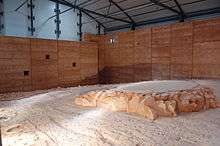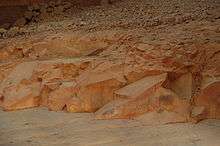Lark Quarry Dinosaur Trackways






Dinosaur Stampede National Monument at Lark Quarry Conservation Park (also known just as Lark Quarry or Dinosaur Stampede) in Australia is considered to be the site of the world's only known record of a dinosaur stampede,[1] with fossilised footprints are interpreted as a predator stalking and causing a stampede of around 150 two-legged dinosaurs. This interpretation has been challenged in recent years, with evidence suggesting it may have been a natural river crossing[2] In 2015 Shire of Winton invited the Australian Age of Dinosaurs Museum of Natural History to take over the operation of public guided tours at Dinosaur Stampede National Monument. This joint initiative, implemented in April 2016, provides visitors with a broader understanding of unique Australian dinosaurs and the world they inhabited.
The Lark Quarry site is about 110 km (68 mi) south west of the western Queensland town of Winton.
Origin
The traditional account is that a group of perhaps 180 chicken-sized coelurosaurs and Bantam to emu-sized ornithopods were disturbed by the arrival of a single much larger theropod, perhaps Australovenator or a related form, which may have been up to 6 metres long with 50-centimetre feet. The different track types are placed within the ichnotaxa Skartopus (coelurosaurs), Wintonopus (ornithopods) and Tyrannosauropus (large theropod).
The Skartopus and Wintonopus trackmakers were thought to have stampeded past the Tyrannosauropus trackmaker, leaving thousands of footprints in the surrounding mudflat.[3] More recent research[4] by the University of Queensland has indicated that the Tyrannosauropus prints were produced by a large herbivore similar to Muttaburrasaurus, rather than by a predatory theropod.[5]
Additional research by Romilio et al. published in the Journal of Vertebrate Paleontology in 2013 casts further doubt on the original interpretation. Analysis of the sediments indicates that they were deposited by a seasonal water course with water flowing at different depths and speeds at different times. The footprints were most likely made over a period of time, perhaps several days, by dinosaurs crossing the channel. The authors also found no significant difference in the form of the footprints attributed to both Skartopus and Wintonopus, and suggest that they were made by different-sized animals of the same species.
Whatever actually took place, not long after the incident, the water level began to rise, covering the tracks with sandy sediments before the mud had dried. The footprints were buried beneath sand and mud as the water levels continued to rise and fall. Over thousands of millennia, the rich river plain with sandy channels, swamps and lush lowland forest dried up. The sediment covering the footprints was compressed to form rock.
Discovery and preservation
The footprints were first discovered in the 1960s by station manager in the nearby Seymour Quarry.
Palaeontologists from the Queensland Museum and the University of Queensland excavated Lark Quarry during 1976–77 (the quarry was named after Malcolm Lark, a volunteer who removed a lot of the overlying rock.) All together they removed more than 60 tonnes of rock, and uncovered about 210 square metres of the layer with the fossils. This shows about 3300 dinosaur footprints.
A sheltering roof was built over the site but did not stop the gradual damage caused by exposure to the weather. The present Conservation Building that covers the trackways was constructed in 2002. This building protects the main collection of footprints from damage by stabilising temperature and humidity fluctuations, stops water running over the footprints and keeps people and wildlife off the footprints themselves.
The Dinosaur Stampede National Monument was included in the Australian National Heritage List on 20 July 2004, for values of rarity and research.[6]
See also
References
- ↑ http://www.derm.qld.gov.au/parks/lark-quarry/index.html Queensland Parks and Widelife Service: Lark Quarry Conservation Park
- ↑ http://theconversation.com/no-dinosaur-stampede-at-lark-quarry-so-what-really-happened-28971 The Conversation No dinosaur stampede at Lark Quarry – so what really happened?
- ↑ Australian National Heritage list: Department of the Environment, Water, Heritage and the Arts
- ↑ Anthony Romilio, Steven W. Salisbury, A reassessment of large theropod dinosaur tracks from the mid-Cretaceous (late Albian-Cenomanian) Winton Formation of Lark Quarry, central-western Queensland, Australia: A case for mistaken identity, Cretaceous Research, In Press, Corrected Proof, Available online 22 November 2010, ISSN 0195-6671, doi:10.1016/j.cretres.2010.11.003.
- ↑ Australia’s biggest carnivorous dinosaur forced to take a walk UQ News, 16 December 2010
- ↑ "Lark Quarry (Place ID 105664)". Australian Heritage Database. Department of the Environment.
External links
- Lark Quarry Dinosaur Trackways - official site
- Queensland Government tourist information about Lark Quarry
Coordinates: 23°00′58″S 142°24′41″E / 23.0161°S 142.4114°E